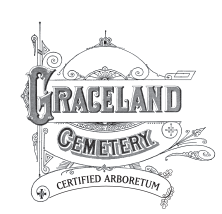Sleepers, reapers, meatpackers, international reporting, a piano for every parlor – ideas and industry have always been a great team in Chicago. And Graceland is well represented with some of the biggest names in midwestern commerce.
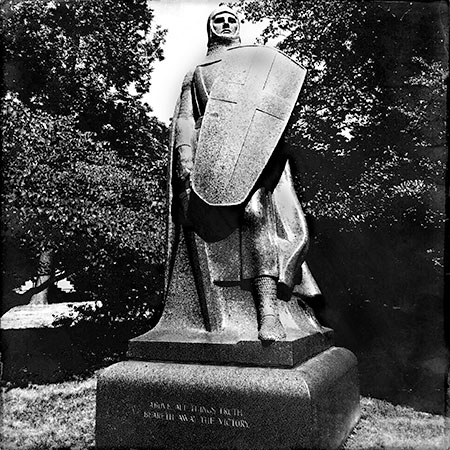 Victor Lawson, 1850 - 1925
Victor Lawson, 1850 - 1925
A Lorado Taft sculpture, “Crusader,” stands guard over the grave of newspaper publisher Victor Lawson, whose Chicago Daily News pioneered in sending reporters throughout the world for news. Lawson contributed anonymously to many of Chicago’s charitable causes, and even his grave is unmarked, except for the statue and the phrase, “Above all things truth beareth away the victory.” It refers to a story in the Book of Esdras, King James Bible Apocrypha, about a discussion of what is strongest.
 George Pullman, 1831 - 1897
George Pullman, 1831 - 1897
If you decide to sit and rest at the Pullman exedra (which means it has seats) you might well use the time to ponder what’s between you and George Pullman, the famous inventor of the sleeping car and the infamous landlord of his workers.
Solon Beman, who built Pullman’s feudally run town, designed the stately Corinthian column. But what’s underground is more interesting: Pullman’s coffin, covered in tarpaper and asphalt, is sunk in a concrete block the size of a room. On top of the block lie railroad ties and even more concrete. Why so secure? The family feared that Pullman’s angry workers, whose wages were cut while their rents remained the same, would resort to skullduggery at the gravesite.
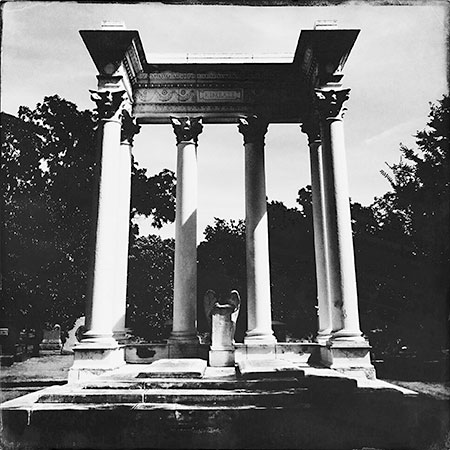 William Kimball, 1828 – 1904, a traveling salesman from Maine, stopped in Chicago in 1857, and was so impressed with its vitality, he stayed and went into business as a wholesale dealer in pianos and organs. By 1881, he was successful enough to open an organ factory, and six years later, began making pianos, too.
William Kimball, 1828 – 1904, a traveling salesman from Maine, stopped in Chicago in 1857, and was so impressed with its vitality, he stayed and went into business as a wholesale dealer in pianos and organs. By 1881, he was successful enough to open an organ factory, and six years later, began making pianos, too.
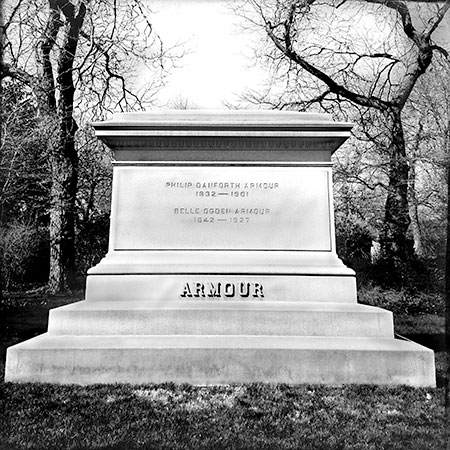 Phillip Armour, 1832 – 1901, came to Chicago from Milwaukee to take over business enterprises from an ailing brother. Armour and his Chicago competitors Swift and Libby became the barons of the meatpacking industry, centered in the Union Stock Yards. It was said that the Chicago packers used all the pig but the squeal. The Armour plant closed in 1959, but his legacy remains. Armour helped build a technical school in 1893, the Armour Institute, which later merged into the Illinois Institute of Technology.
Phillip Armour, 1832 – 1901, came to Chicago from Milwaukee to take over business enterprises from an ailing brother. Armour and his Chicago competitors Swift and Libby became the barons of the meatpacking industry, centered in the Union Stock Yards. It was said that the Chicago packers used all the pig but the squeal. The Armour plant closed in 1959, but his legacy remains. Armour helped build a technical school in 1893, the Armour Institute, which later merged into the Illinois Institute of Technology.
Lucius Fisher, 1843 – 1916, fought for the Union during the Civil War and settled in Chicago afterward. He became president of the Union Bag & Paper Company, and founded the Exhaust Ventilator Company. His monument is actually an early columbarium – a vault to hold urns of cremated remains, a practice much more common today than a century ago.
John Glessner, 1843 – 1936, was, by all accounts, steady, dedicated to his work, devoted to his family and the finer things in life. He was Vice President of the very successful International Harvester Company, but you wouldn’t know it from the plain Glessner family plot at Graceland. Their Chicago home, however, is another story – Glessner left it for the people of Chicago as a museum. The Glessners were also instrumental in the founding of the Chicago Symphony, and supporters of the Art Institute, Rush Medical College and the Commercial Club.
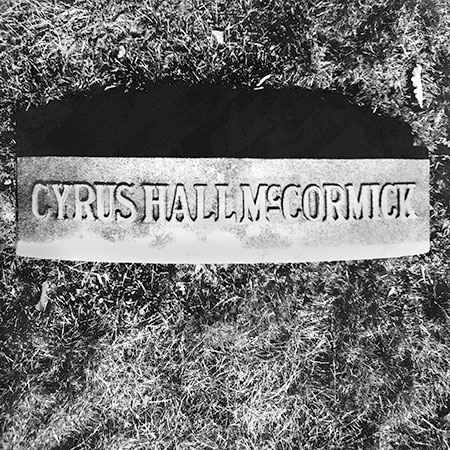 Cyrus McCormick, 1809 – 1884, is another man of means with a simple headstone at Graceland. Only 22 when he invented his world-changing reaper, he also pioneered the installment plan, allowing farmers to buy “on credit.” He built his first Chicago factory in 1847, and became one of the city’s largest employers as well as a millionaire.
Cyrus McCormick, 1809 – 1884, is another man of means with a simple headstone at Graceland. Only 22 when he invented his world-changing reaper, he also pioneered the installment plan, allowing farmers to buy “on credit.” He built his first Chicago factory in 1847, and became one of the city’s largest employers as well as a millionaire.
